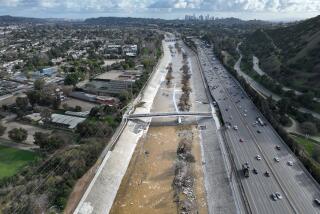Orange County, Inland Empire bore brunt of storms
In the run-up to what became one of the worst storm systems to hit Southern California in five years, all the concern was focused on the Los Angeles foothill communities scarred by the Station fire.
But when the wildest weather arrived Wednesday, the worst-hit areas were not La Cañada Flintridge or La Crescenta in the San Gabriel Mountains.
Instead, by the luck of the draw, the heart of the storm plunged straight into Orange County and the Inland Empire, giving those areas a soaking that residents said was the worst in recent memory.
The storms were one of the most powerful systems to strike Southern California since the memorable El Niño storms of the winter of 2004-05. And they seemingly embarrassed weather forecasters and climatologists who had earlier predicted that because of La Niña, this winter would be drier than average.
Laguna Beach was doused with 4.29 inches of rain in just 24 hours — nearly half of what the city has received all week. A storm drain channel that normally diverts excess water underneath downtown and into the ocean surged over its barriers, bursting onto Beach Street, pulling down a chain-link fence and sending water spraying up to 15 feet in the air.
The storms reduced Laguna Gardens Nursery to a field of broken pottery, strewn bricks and toppled stonework, pushing over statues of Buddha weighing several hundred pounds.
“There have been three floods here since 1981, but this one was by far the most violent .... Everything’s gone,” said Kevin Naughton, 57.
“There are rivers coming through town,” said Jeff Grubert, 48, an entertainment distribution company manager who has an office in Laguna Beach.
At sunrise, heavy, knee-high muck caked downtown streets, miring cars up to their doors. High tides collided with rivers of water gushing down Broadway and Pacific Coast Highway, wiping out much of the main beach downtown and washing away the sand beneath the popular boardwalk.
The floors of many of the restaurants, rug galleries, bars and clothing boutiques were covered in water, with mounds of sand piled up on their doorsteps.
“This is not good,” said Kelly Boyd, a Laguna Beach city councilman and owner of the popular local watering hole the Marine Room. Its wood floors were soaked and buckling. “We cannot get flood insurance in town because it is on a flood plain.”
The flotsam on one stretch of downtown sidewalks included patio furniture, CDs and uprooted vegetation.
What was Orange County’s misfortune offered L.A. County a reprieve. L.A. County officials had feared a repeat of the Feb. 6 floods, when a slow-moving storm cell parked itself near La Cañada Flintridge, unleashing a torrent that tossed a huge boulder into a storm drain, clogging it and then pushing muddy rapids into 40 homes.
But on Wednesday, debris basins remained 70% to 75% empty, said Bob Spencer, spokesman for the county Department of Public Works.
“There wasn’t a lot of material that came down the hills this time around,” he said.
At first glance, the result was somewhat surprising because La Cañada Flintridge received more rainfall over the last seven days than the region did before the Feb. 6 storms, said Bill Patzert, climatologist at the Jet Propulsion Laboratory.
But there were key differences. For one thing, much of the loose debris had already washed away, Patzert said. And before the Feb. 6 floods, county crews were still struggling to clear debris basins of the products of previous storms.
Spencer cautioned that the lack of disaster this time should not encourage residents who ignored evacuation orders issued Tuesday night. Because topsoil has eroded from the slopes since the fires, more boulders are now exposed and are even more likely to tumble.
“We really, really dodged a bullet,” said meteorologist Jamie Meier of the National Weather Service.
The weather service said 8.35 inches of rain had fallen on downtown L.A. so far this December, making it possible that this month will break the record for the second-wettest December — 8.77 inches during the El Niño storms of December 2004. But it is unlikely to break the all-time record of December rains, when more than 15 inches fell in December 1889.
Normal December rainfall for downtown L.A. is 1.9 inches.
The heavy rainfall has raised questions about whether this year really will be drier than average. Perhaps not surprisingly, Meier said climatologists are now predicting “equal chances of a drier or wetter than normal year.”
“Who would have ever thought that we would be reaching the second-wettest December during a La Niña year?” she said.
Unlike El Niño years, which result from a warming of the tropical Pacific Ocean and can cause heavier rainfall here, a La Niña event is caused by a cooling of the same waters and usually brings less rainfall.
Patzert said that since 1949, there have been 22 La Niña events; 18 of those years brought below-average rainfall to the region.
A reprieve from the rain is expected to last through early Christmas Day. A new but far weaker storm was expected to land Saturday night and last into Sunday.
More to Read
Sign up for Essential California
The most important California stories and recommendations in your inbox every morning.
You may occasionally receive promotional content from the Los Angeles Times.












